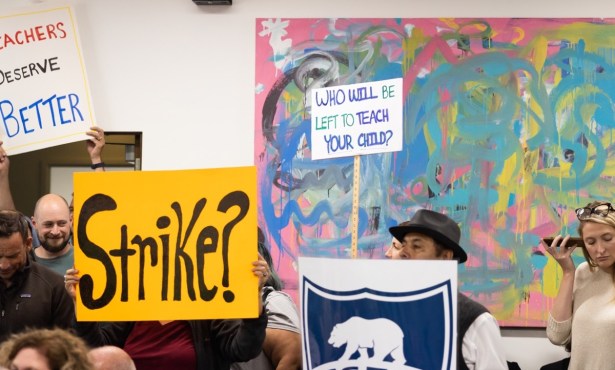In the Education Trenches
How Parcel-Tax Vote Will Affect the Classroom

Band is Salvador Valencia’s favorite class. The 7th grader at La Cumbre Junior High School has been playing the violin for four years, but a few weeks ago, he decided to try the clarinet. As he practiced with his classmates last Tuesday, his rawness on the new instrument was evident, high-pitched squeaks periodically escaping from his woodwind. Rather than get discouraged, the curious Valencia asked his teacher what caused the squeaks. She answered hurriedly, indicating that he may have too much mouthpiece in his mouth or maybe he isn’t covering his finger holes completely, before returning to conducting the entire class.
Teaching band at La Cumbre is a bit like juggling knives. The same class is composed of novices and experts, all with the attention span of, well, teenagers. Instead of specializing the classes at the junior high school, its administrators give every student the opportunity to partake of the elective, no matter their skill level or instrument. Doing the juggling is Nancy Mathison, a 17-year veteran in the Santa Barbara school district and a concert clarinetist herself. Twice the recipient of “Reduction in Force” pink slips due to budget constraints, Mathison is now funded mostly by parcel tax H, which was passed in 2008 to supplement education in Santa Barbara’s secondary schools. Along with Measure I — for the elementary district — these two revenue measures placed a lump-sum tax of $23 and $27, respectively, on properties in the district, with exemptions allowed for seniors.
Measure H funds 12 full-time equivalent teachers or 60 class sections, impacting more than 2,200 student schedules in music, art, theater, math, and foreign language classes. The elementary school measure funds the salaries of five full-time music teachers — instructing a combined 5,000 students — and pays for classroom technology as well as support for math and science teachers.
Those measures will sunset at the end of this school year. Two new measures on the current ballot as A and B would replace them. These measures, however, ask for about twice as much money — $45 for A and $48 for B — to compensate for more than $20 million in budget cuts in the past four years since H and I passed. If they don’t pass, class sizes will increase, and teachers will lose their jobs. Because of her seniority, Mathison probably does not need to worry, but less-senior music teachers do.
Some detractors of the measures worry that parcel taxes, introduced as a stopgap, may become the new normal. Current school boardmember Ed Heron campaigned on the promise that the district wouldn’t need new parcel taxes, but now he says he couldn’t have predicted the deep cuts the district has had to endure. “I wish we didn’t have to extend them,” he said, but he supports them. School board candidate Lou Segal opposes the measures, arguing that taxpayer commitments should be accompanied by reforms.
When the Republican Central Committee voted on whether to endorse or oppose, it put the measures on the firing line, cocking and aiming in the form of a motion to oppose along with a second. But right before the committee members voted, someone in attendance pointed out that school district Superintendent David Cash was in the audience along with Noozhawk editor Bill Macfadyen, who came as a representative of the Santa Barbara Education Foundation. Cash said he was allowed to make a last-minute pitch before he and Macfadyen were kicked out of the room. After a discussion took place, they were asked back in, and the committee decided to take no position. The conservative County Taxpayers Association actually endorsed the measures.
The conservative argument for them is that the taxes are levied and controlled locally, uninhibited from the palimpsests of legislation and convoluted funding formulas that make state funds disappear into the ether. The spending of those dollars is extremely transparent, attests former school boardmember and conservative doyen Lanny Ebenstein, who sat on the Measure H Citizens’ Oversight Committee.
Ebenstein showed his support by marching in a rally for the measures two weeks ago in which Mathison spoke to make her case for music education, which she says offers many children a reason to attend school, stay in school, and keep off the streets. Other speakers at the rally — like Tariqh Akoni, a San Marcos graduate who regularly accompanies Stevie Wonder — delivered eloquent defenses of the arts. But Santa Barbara High School math teacher Joyce Adriansen, who attended the rally, said she wished there had been more explanation that Measure H also limits freshman high school math classes to a 20:1 ratio. “The difference in the level of help I can give each student is phenomenal,” she said, when comparing to classes with the district maximum of 38 students.
Measures A and B would generate $2.9 million in revenues per year for four years. As well as maintaining current parcel-tax-funded resources, they would fund technology training for teachers, as well as career technical courses in secondary schools. They require a two-thirds majority to pass.



